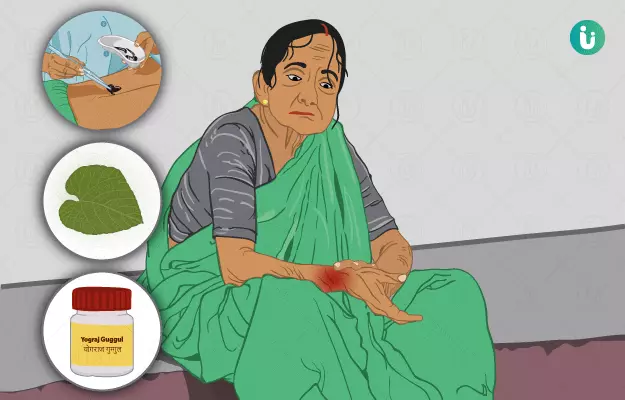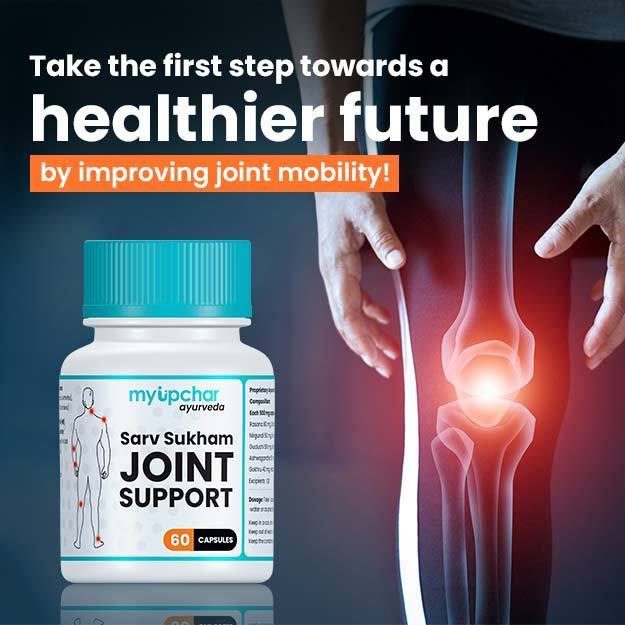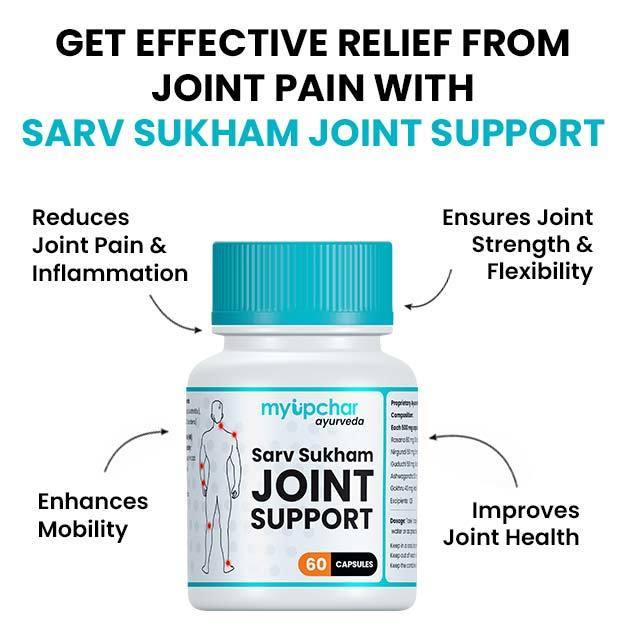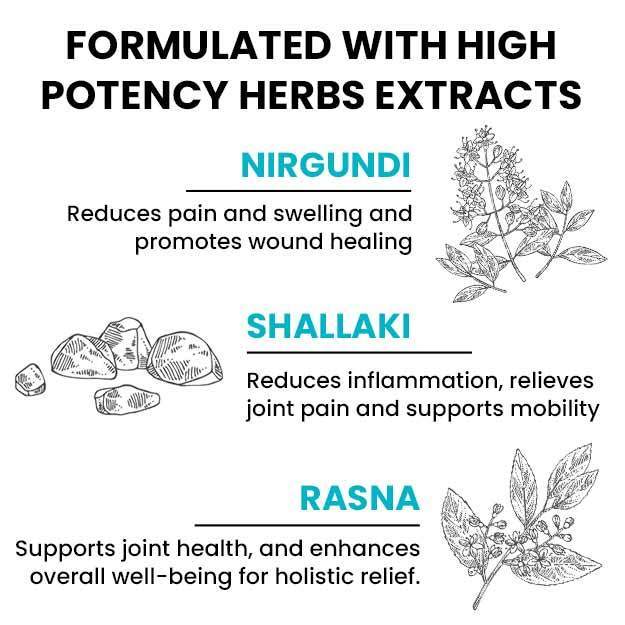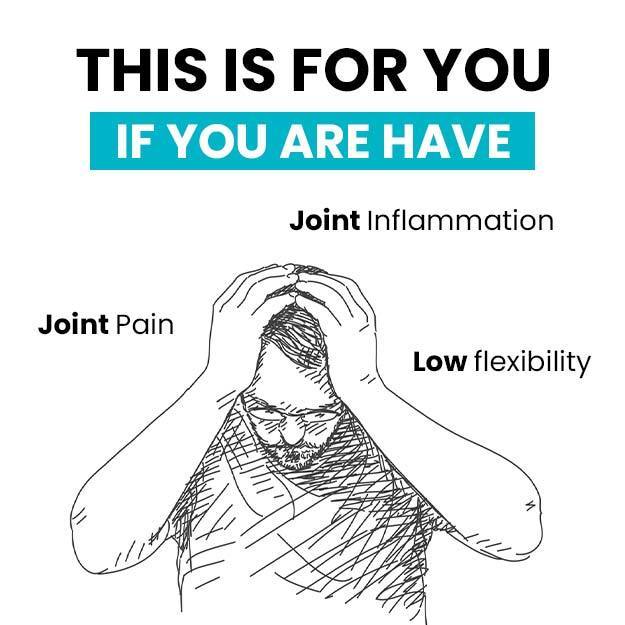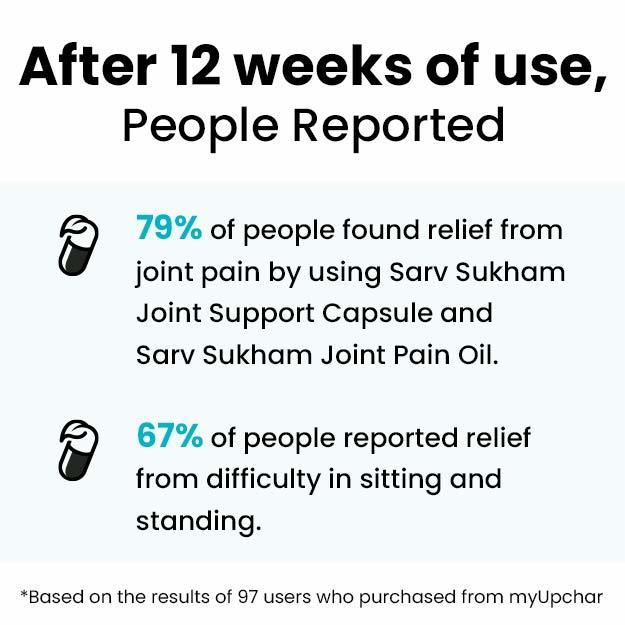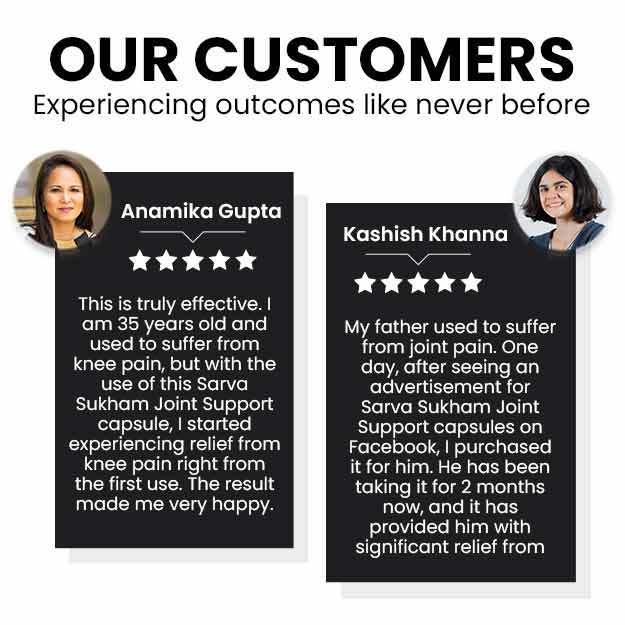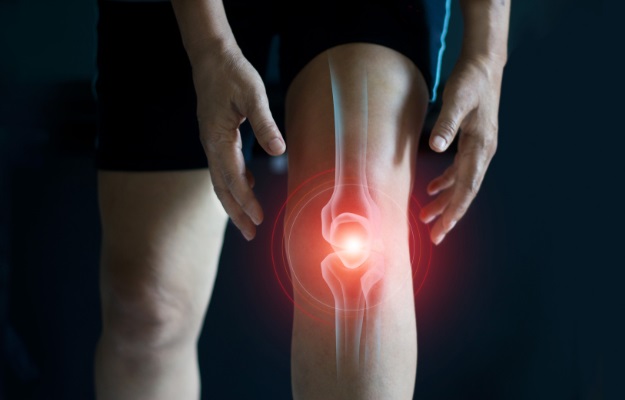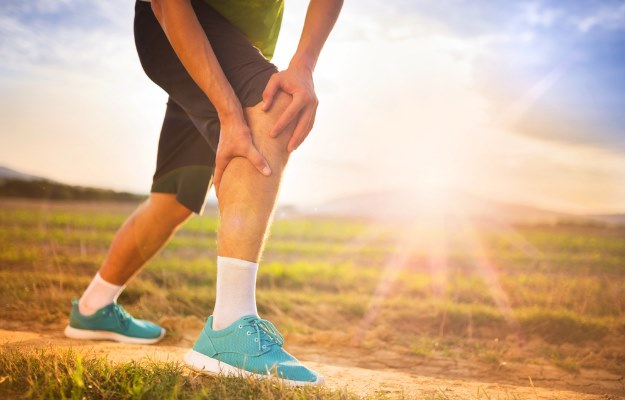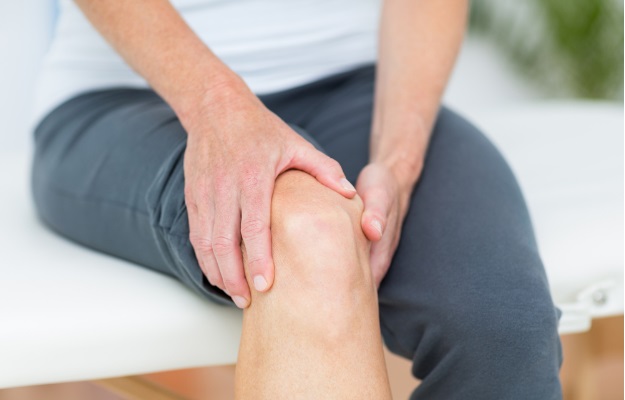Arthritis is an inflammatory condition characterized by pain and swelling in the joints, which can be mild to severe. It can affect individuals of any age, sex or race. The most common type of arthritis is osteoarthritis, a degenerative arthritis occurring due to the ageing of the bones and joints. Rheumatoid arthritis is an autoimmune disease occurring when the tissues of the body are attacked by its own immune system, leading to inflammation of the joints.
Ayurvedic treatments for arthritis include swedana (sudation or sweat therapy), raktamokshana (bloodletting), virechana (purgation), basti (enema), lepa (coating the affected body part with medications) and agni karma (thermal cauterisation). Herbs and medicines used for the appropriate management of arthritis include shallaki (Indian frankincense), bala (country mallow), pippali (long pepper), eranda taila (castor oil), nirgundi (five-leaved chaste tree), ashwagandha (Indian ginseng), guduchi (heart-leaved moonseed), trikatu (three acrids), simhanada guggulu, dashmoola kwatha, yogaraja guggulu and amrutadi kwatha.
- Ayurvedic view of arthritis
- Ayurvedic treatment for arthritis
- Ayurvedic herbs and medicines for arthritis
- Dietary and lifestyle changes for arthritis patient as per ayurveda
- How effective are ayurvedic medicines and treatments for arthritis
- Side effects and risks of ayurvedic medicine and treatments for arthritis
- Takeaway
Ayurvedic view of arthritis
As per Ayurveda, there are three basic types of musculoskeletal joint diseases, which are classified on the basis of their causes and symptoms. They are amavata, sandhivata, and vata rakta and closely resemble rheumatoid arthritis, osteoarthritis, and gouty arthritis, respectively. All three types are characterised by pain and inflammation in the joints. Let us have a closer look at each of them individually.
- Amavata: It is caused due to accumulation of ama (toxins) accumulates in the joints. It involves multiple joints, and the accumulated ama in the joints causes pain, swelling and stiffness of the joints. It also affects the rigid joint at the back of the pelvis between the sacrum and the ilium. The common symptoms that are associated with amavata are fever and loss of appetite.
- Sandhivata: This is caused due to accumulation of vitiated vata in the joints; thus, medicines that act on both, vata and asthi (bones), should be used for the treatment. Symptoms include pain in one or more joints which affects and restricts the movements of those joints. This type of arthritis may present itself with or without swelling and crepitus. It is generally seen in old age and is the most common form of arthritis.
- Vata rakta: It is a disease caused due to vitiated vata and rakta. In this condition, the aggravated vata is obstructed by vitiated rakta, which, in turn, leads to vitiation of the entire rakta. The common clinical symptoms of vata rakta are pain, inflammation, redness and swelling in the joints. It can further be categorised into two types:
- Uttana- confined to the twak (skin) and mamsa (muscles)
- Gambhira- affects the deeper tissues and organs of the body.
Ayurvedic treatment for arthritis
Nidana parivarjana
- In ayurveda, nidana parivarjana is one of the first lines of treatment against any disease. It mainly involves avoidance of the factors that cause disease. Nidana parivarjana stops disease progression and prevents the recurrence of the disease.
- Depending on the type of arthritis, its causes may be addressed by changing food habits such as alpashana (eating less quantity of food), anashana (fasting) pramitashana (eating limited quantity of food), ruksha annapana sevana (eating foods that are dry) and behavioural changes such as avoiding excessive physical activity.
Swedana
- Swedana is a type of treatment wherein steam is given to the body to induce sweating. However, for treating arthritis, upanaha swedana is used. Upanaha is a type of swedana that involves the application of hot poultice over the body, generally in the affected areas. The poultice is made of a combination of herbs that are selected depending on the condition. It is widely used in the management of rheumatoid arthritis.
Shodhana chikitsa (purification therapy)
- Raktamokshana
- It is a procedure that is used to eliminate the impure blood from specific areas of the body.
- Blood is removed by utilising bottle gourd, needle, horn, leech, or by scarification. The method varies depending on the individual's strength and morbidity.
- It eliminates ama, thereby, preventing toxin accumulation in joints and aggravation of vata. This makes it useful in the management of rheumatoid arthritis as well.
- Raktamokshana is considered to be the main treatment for gouty arthritis as it is caused due to vitiation of rakta and vata. Leech therapy is used to perform raktamoksahana in individuals with gouty arthritis.
- Virechana karma
- Ama is the cause of most clinical conditions including arthritis. Virechana karma involves the use of certain herbs that induce emptying of bowels and removal of ama from the body.
- For the treatment of rheumatoid arthritis, virechana karma is performed by using trivritta avaleha and abhayadi modaka.
- Virechana karma is useful in the management of gouty arthritis and in obese individuals with osteoarthritis.
- Basti karma
- It is an Ayurvedic enema that is used to cleanse the entire length of the colon. Basti karma is primarily used for the treatment of aggravated vata.
- Along with balancing of the vitiated dosha, it also detoxifies the body and removes ama from the body.
- Vaitarana basti, kshara basti and ardha matrika niruha basti can be used for relieving symptoms of rheumatoid arthritis.
- Mahanarayana taila, masha taila, prabhanjana vimardana taila, vishagarbha taila and bala taila are used for basti karma in individuals with osteoarthritis.
- Brihatsaindhavadi taila, madhuyashtyadi taila and kshirabala taila are commonly used for basti karma in gouty arthritis.
External treatment
- Lepa
- Lepa is a combination of herbs applied topically, commonly used to reduce inflammation and swelling.
- Dashanga lepa or lepa gutika, grihadhoomadi lepa, jatamayadi lepa, kottamchukkadi lepa, etc., are used for treating rheumatoid arthritis.
- Agni karma
- Typically, the most painful point of the joint is burned with a special instrument for agni karma.
- Agni karma on the affected joints helps in the management of osteoarthritis.
Ayurvedic herbs and medicines for arthritis
Ayurvedic Herbs for Arthritis
- Shallaki
- Shallaki is a well-known herb that possesses anti-inflammatory and analgesic properties. It helps in reducing inflammation and pain in case of rheumatoid and osteoarthritis.
- It pacifies vata dosha and is useful in the management of various vata-related conditions.
- Shallaki is known to keep the joints strong. It is an anti-inflammatory, anti-arthritic and also protects the heart.
- Bala
- Bala is an important herb useful in the strengthening of the heart and body. It helps in healing inflamed tissues and is useful in chronic rheumatism and joint diseases. It is also useful in osteoarthritis.
- It should not be taken if the individual has severe nasal and chest congestion.( Read more: Nasal congestion treatment)
- Pippali
- Pippali has carminative (reduces bloating) digestive, stimulant, emetic (induces vomiting) and rejuvenating properties.
- It alleviates kapha and vata dosha.
- Pippali is used in the management of pain, inflammation and stiffness of the joints in rheumatoid arthritis, osteoarthritis and gout. It is also useful in the management of fever, diabetes, tuberculosis, skin disorders and spleen disorders.
- It should be used with caution as it causes increased levels of pitta dosha.
- Eranda
- Eranda oil is used in the management of the pain, inflammation, swelling and stiffness experienced in rheumatoid arthritis, osteoarthritis and gout.
- It is also used in the management of conditions such as bronchitis, colic pain, and appendicitis. It should be noted that refined castor oil is less effective as compared to its unrefined alternative.
- Nirgundi
- It has multiple therapeutic effects, and the roots, bark, leaves and flowers of this plant are useful in the management of various conditions like malaria, ear disorders, ulcers, swelling and nausea.
- Nirgundi leaves are used externally in the management of inflammation and swelling of the joints in acute rheumatism. Its anti-inflammatory properties are also helpful in the management of osteoarthritis.
- Ashwagandha
- Ashwagandha alleviates the vitiated vata and kapha doshas.
- It nourishes the body and acts as an immune booster. The anti-inflammatory activity of ashwagandha helps in the treatment of rheumatoid arthritis and osteoarthritis.
- It is also useful in the management of leucoderma, cough, oedema and skin diseases.
- Individuals with nasal and chest congestion should not take ashwagandha.
- Guduchi
Ayurvedic Medicines for Arthritis
- Trikatu
- It is a combination of ginger, black pepper and long pepper. A mixture of these three pungent drugs stimulates the enzymes in the body. These herbs are also effective in the treatment of all three types of arthritis.
- It is an essential combination in Ayurveda and used as a carminative, stimulant.Trikatu also helps in the management of cold.
- Simhanada guggulu
- Simhanada guggulu consists of vibhitaki (belleric myrobalan), amalaki (Indian gooseberry), shuddha gandhak (pure brimstone), shuddha guggulu (pure Indian bdellium-tree), haritaki (chebulic myrobalan) and eranda moola (castor roots).
- It increases digestive power, improves digestion of ama, reduces excessive production of kapha and removes the obstruction in the circulatory channels. Thus, proving effective in the management of rheumatoid arthritis.
- It prevents the ama from lingering around the site of the pathogenesis of the condition.
- Dashmoola kwatha
- Dashmoola kwatha is a decoction made from the roots of ten different herbs, which include bilwa (golden apple), shyonaka (Indian caper), agnimantha (headache tree), gambhari (beechwood), prishniparni (kalshi), brihati (bari katheri), kantakari (chhoti katheri), and gokshura (small caltrops).
- It is mainly used for the treatment of diseases caused by aggravated vata such as arthritis.
- Other diseases that can be treated with this medicine are asthma, fistula and cough ( all caused due to vata). It also is useful in degenerative diseases of the bones like osteoarthritis and bone-related diseases that are accompanied by fever.
- Yogaraja guggulu
- This formulation consists of chitraka (leadwort), pippalimoola (long pepper roots), parsika yavani (stinking nightshade), vidanga (false black pepper), rasna (Indian camphorweed), gokshura, twak (cinnamon), guduchi, guggulu, shatavari (hundred roots), etc.
- It is useful in all kinds of vata diseases, especially rheumatoid arthritis.
- In chronic rheumatoid arthritis, mahayogaraja guggulu works the best.
- It is also useful in gouty arthritis where vitiated vata vitiates rakta.
- Yogaraja guggulu pacifies vata dosha as well as eliminates ama.
- Amrutadi kwatha
- The main ingredient in Amrutadi kwatha is amruta (guduchi). Amruta helps in agnimandya (dyspepsia). It increases the flow of digestive fire, which improves digestion and increases hunger.
- It is useful in chronic amavata and sandhivata. It also strengthens the liver.
As treatments vary according to numerous factors and an individual’s prakriti (constitution), consult a qualified Ayurvedic doctor for the appropriate medications and treatments for your specific complaints.
Dietary and lifestyle changes for arthritis patient as per ayurveda
Do’s
- Rheumatoid arthritis
- Include cereals like barley and the red variety of shali rice in your diet.
- Include pulses like kulattha (horse gram) in the diet.
- Consume vegetables like paravala (pointed gourd), methi (fenugreek), drumstick and bitter gourd.
- Include shunthi (dried ginger), adraka (ginger), ajowan (caraway), fennel, black pepper, rock salt, asafoetida, garlic, cumin, and buttermilk in the diet.
- Exercise regularly.
- Osteoarthritis
- Include wheat and rice in the diet.
- Consume black gram, green gram and kulattha.
- Take fruits and vegetables like patola (sponge gourd), drumstick, brinjal, garlic, phalsa (falsa), pomegranate, lemon, jujube plum and grapes.
- Include clarified butter, milk, coconut water, sour vinegar and tamarind in your diet.
- Sleep adequately.
- Posture correction and regular massage can also be of help.
- Gouty arthritis
- Include green gram, wheat, barley, goat milk and cow milk in your diet.
- Include the lifestyle changes prescribed by your doctor in your routine.
Don’ts
- Rheumatoid arthritis
- Do not include black gram in the diet.
- Do not overeat. Avoid heavy meals or food items that are too heavy to digest, e.g., all dairy products except buttermilk, fish, jaggery, raw vegetables and salads, potatoes, and sour foods like tamarind, lemon, etc.
- Do not suppress natural urges such as urination and bowel movements.
- Avoid daytime sleeping and physical exertion just after a meal.
- Osteoarthritis
- Do not include dry and raw vegetables, lentils, sprouts, salads, refined foods, mushrooms and peas in your diet.
- Do not change your sleep pattern frequently.
- Do not suppress natural urges like hunger and emptying of the bowel or bladder.
- Avoid excessive intake of green leafy vegetables.
- Avoid excessive intake of cold drinks, beverages, pungent food items, chilled foods and ice cream in the diet.
- Avoid fasting for a long duration or consumption of food in a limited amount.
- Avoid excessive physical strain and excessive joint movements.
- Gouty arthritis
- Do not include black gram and horse gram in your diet.
- Do not include refined foods like white flour and fermented foods in your diet.
- Do not suppress natural urges.
- Avoid daytime sleep, excessive physical activity and excessive exposure to sun.
How effective are ayurvedic medicines and treatments for arthritis
- Rheumatoid arthritis
A study conducted on a 45-year-old individual diagnosed with rheumatoid arthritis indicated the effectiveness of Ayurvedic therapies on this condition. The treatment involved deepana (hunger-increasing medicines) and pachana (digestives) with amapachana vati followed by shunthi churna. Snehana (oleation) was given using cow’s ghee, followed by swedana. Later, virechana karma was performed using trivrita avaleha and castor oil. It was found that after the completion of virechana karma, the person experienced 40% relief in the pain and stiffness of the joint. The requirement of pain-relieving and anti-inflammatory modern medicines was also reduced by 50%. Follow-up at 1 year showed complete relief from ama, vata and improvement in the quality of life.
- Osteoarthritis
A study involving 49 participants with osteoarthritis in the age group 30 to 70 years was conducted to check the effects of ayurvedic treatments on osteoarthritis. All the participants were divided into two groups based on Ayurvedic treatment measures. Group A was treated using local abhyanga (massage) with bala taila, swedana with dashamoola kwatha, and panchatikta ghrita guggulu vati for 30 days. Group B received the same treatment without the panchatikta ghrita vati for 21 days. Although both treatment methods provided relief in a majority of the participants, it was found that more individuals in Group A reported relief from the symptoms of osteoarthritis.
- Gouty arthritis
A study involving a 47-year-old male with swelling and pain in the right knee joint, body pain and excessive sweating was conducted to assess the efficiency of various ayurvedic treatment on gout arthritis. The treatment involved virechana karma and medicines such as yogaraja guggulu, chopchini (china root), rasna, dashmool, punarnava (red hogweed), gandharva haritaki, and kaishora guggulu. Nearly all the symptoms were found to disappear after treatment for 15 days, indicating the effectiveness of Ayurvedic therapy.
Side effects and risks of ayurvedic medicine and treatments for arthritis
The concept that natural remedies are free of side effects seems to be very popular; however, excessive and unwarranted use of herbal medicines and treatments can be harmful to health. Thus, Ayurvedic remedies should not be used without consulting an experienced Ayurvedic physician as they can lead to side effects. For example, virechana should not be used in weak individuals and pregnant women, and pippali should be used with caution in cases of aggravated pitta.
Takeaway
Arthritis is the most common cause of pain and inflammation of the joints in a wide range of population. Also, arthritis due to increasing age is widely prevalent. Joint pain majorly affects our routine and quality of life. Although this pain is physical, it also affects our focus and concentration at work. Using Ayurvedic treatments and herbs can help get rid of the arthritic pain more holistically and lead you to a pain-free and healthy life.
References
- Arthritis Foundation. What Is Arthritis?. Atlanta, Georgia, United States [Internet].
- Ministry of AYUSH, Govt. of India. Ayurvedic Standard Treatment Guidelines. [Internet]
- Central Council Of Indian Medicine. Standard Treatment Guidelines in Ayurveda. . New Delhi, India [Internet].
- Shweta A. Pandey, Nayan P. Joshi, Dilip M. Pandya. Clinical efficacy of Shiva Guggulu and Simhanada Guggulu in Amavata (Rheumatoid Arthritis). Ayu. 2012 Apr-Jun; 33(2): 247–254, PMID: 23559798.
- Bhushan Patwardhan. Bridging Ayurveda with evidence-based scientific approaches in medicine. EPMA J. 2014; 5(1): 19, PMID: 25395997.
- Sanjay Kumar Gupta, Anup B Thakar, Tukaram S Dudhamal, Aditya Nema. Management of Amavata (rheumatoid arthritis) with diet and Virechanakarma. An International Quarterly Journal of Research in Ayurveda, Volume : 36 Issue : 4, 2015.
- Babul Akhtar. Clinical study on Sandhigata Vata w.s.r. to Osteoarthritis and its management by Panchatikta Ghrita Guggulu. Ayu. 2010 Jan-Mar; 31(1): 53–57, PMID: 22131685.
- Ramteke R. Case Report Open Access Management of Rheumatoid Arthritis through Ayurveda. Journal of Traditional Medicine & Clinical Naturopathy, 5:189, 2016.
- Deepthi Viswaroopan et al. Undernutrition In Children: An Updated Review. International Journal of Research IN, 8 (Suppl 2), 2017.
- Lakshmi Chandra Mishra. Scientific Basis for Ayurvedic Therapies . International Ayurvedic Medical Journal, 2004.
- Dr. Nilesh N. Gawande. Contemporary Innovation in Science. International Research Fellows Association’s Research Journey, April-2019.
- Vaidya Bhagwan Dash. Handbook of Ayurveda .Concept Publishing Company (1987) : Delhi, India.
- Rajiv Gandhi Government Post Graduate Ayurvedic College. Kayachikitsa . Paprola, Himachal Pradesh. [Internet].
- Prof. G.S. Lavekar. Classical Ayurvedic Prescriptions for common Diseases . Central Council for Research in Ayurveda and Siddha. Department of AYUSH, Ministry of Health & Family Welfare, Government of India.
- Dnyaneshwar Kantaram Jadhav. Ayurvedic Management of Vatarakta (gout) - A Case Report. Global Journal of Addiction and Rehablitation Medicine, Volume 2 Issue 3 - June 2017.

